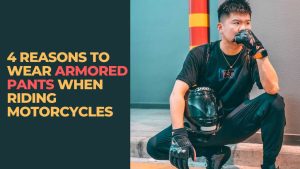KEY POINTS
- Helmets proven effective: Reduce deaths and injuries by over 60%.
- Full face best: Provide highest protection for head and lower face.
- Proper fit critical: Ill-fitting lids reduce protective benefits.
- Replace after crash: Structural integrity weakened even without visible damage.
- New technologies: May further reduce traumatic brain injuries and concussions.
I’ll never forget witnessing a horrific motorcycle accident on the highway last year. A rider had come around the bend a little too fast. His bike slid, somersaulted, and threw him onto the asphalt. As I rushed over to help, I was relieved to see him sit up, pull off his dented helmet, and shrug, helmet clearly saving him from much worse.
This got me wondering—in a field surrounded by steel cages, windshields and airbags, how effective are simple helmets at preventing head injuries and fatalities? Let’s dive into what research reveals.
Helmet Effectiveness in Preventing Accidents: Research-Based Evidence
Numerous studies confirm that motorcycle helmets, when properly worn, reduce the risk of death and severe head injury by 42% and 69%, respectively.
Helmets have been demonstrated to prevent a range of injuries from skull fractures and traumatic brain injuries to severe lacerations.
Though no helmet can safeguard against all crash outcomes, when chosen correctly and carefully adjusted they constitute our best defense against motorcycle fatalities.
We cover the full spectrum of information needed to optimize helmet safety through both product selection and proper wear.
By understanding how motorcycle helmets work and the various options available—from full-face to flip-up—along with maintenance and adjustment considerations, riders can gain the protective advantages of this life-saving equipment.
How Motorcycle Helmets Protect Your Head
A. Types of injuries helmets protect against
Motorcycle helmets are designed to protect the head from a range of potentially serious and life-threatening injuries in the event of a crash.
The primary injuries helmets safeguard against include:
i. Skull fractures
Helmets absorb and dissipate impact forces that would otherwise fracture the skull bones.
Even minor linear skull fractures can lead to bleeding and swelling that put pressure on the brain, so helmets help prevent both minor and severe fractures.
ii. Traumatic brain injuries
By distributing impact forces across a larger area, helmets reduce the deformation and acceleration/deceleration of the brain within the skull.
This minimizes the stretching and shearing of brain tissue that causes concussions and more severe traumatic brain injuries.
iii. Lacerations
The hard outer shell and inner padding of helmets minimize the contact of the rider’s head with road hazards like pavement, debris and other vehicles.
It helps prevent deep lacerations to the scalp and face that can result in blood loss, infection and other complications.
Helmets cannot protect against every type of head injury like some fractures of facial bones. However, they guard the most vulnerable and vital areas of the head by managing impact forces before they reach the skull and brain. And even in crashes where head injuries do occur, helmets often lessen the severity.

B. How helmets work
The primary role of motorcycle helmets is to distribute the force of an impact across a larger area, away from critical areas of the head that are vulnerable to serious injury.
Instead of concentrating all impact energy at the point of contact, the helmet’s structure absorbs and spreads that force out over a broader surface area.
The hard outer shell of the helmet is specially designed to crush and deform upon impact, absorbing some of the energy while transferring the remaining impact to the layers within.
The thick padding sandwiched between the inner lining and outer shell then acts as a shock absorber, compressing further to slow down the deceleration rate of the rider’s head.
This process distributes impact forces across a wider area of the scalp and skull, which helps prevent injuries like fractures and traumatic brain injuries.
Some newer helmets employ advanced technologies like multi-density foams and shear-activated liners that provide even greater energy absorption.
The fit and retention systems of the helmet, consisting of the chinstrap, padding thickness and adjustments, also play an important role in properly positioning the helmet to manage impact forces effectively.
RELATED: What Factors Contribute to Increased Risk of Motorcycle Accidents?
C. Types of motorcycle helmets
There are several main types of motorcycle helmets, each offering a different level of protection and comfort:
Full face: These completely enclose the head and have a durable chin bar that protects the entire face. Full face helmets provide the highest level of protection against impact forces and are recommended for high-speed riding.
Open face: These expose the lower half of the face and lack a chin bar. While more comfortable, open face helmets offer less protection for the chin and lower facial area.
Modular: Also known as flip-up helmets, these have a hinged jaw section that can be opened for ventilation or convenience at lower speeds. They provide similar protection to full face helmets when the chin bar is down.
All types of helmets incorporate features that improve impact protection and safety, such as:
- Integrated visors to block wind, debris and insects while riding.
- Padding of varying thickness and density for comfortable fit and effective energy absorption.
- Advanced retention systems with microlock straps and snap-lock buckles to ensure a snug and secure fit.
- Aerodynamic designs that reduce lifting forces at high speeds.
- Special coatings and finishes that increase durability and longevity.
Regardless of type, all motorcycle helmets should meet official DOT or Snell certification standards.
Effectiveness of Motorcycle Helmets Established By Research
A. Helmets shown to reduce mortality and serious injuries
Numerous research studies provide compelling evidence of the life-saving effectiveness of motorcycle helmets. Rigorous reviews and meta-analyses point conclusively to helmets’ ability to reduce both fatalities and serious injuries in crashes.
For example, a 2017 systematic review of 37 studies found that helmet use reduced the risk of death by 42% and the risk of head injury by 69% in motorcycle crashes. The researchers concluded that motorcycle helmets are “highly effective” in preventing fatal and nonfatal head injuries when properly worn.
Another 2020 meta-analysis that aggregated data from 13 studies found that helmet use led to a 37% lower risk of death and a 64% decrease in head injuries for motorcyclists involved in crashes. The protective effect was found to be even greater for full-face helmets compared to other styles.
A broader 2010 evidence-based review examined 53 observational studies and 13 clinical trials on motorcycle helmet effectiveness. The results showed that helmets significantly decrease both overall mortality and head injury-related mortality from motorcycle crashes. The review concluded that helmet use has a “large protective effect”, with the best evidence for full-face lids.
Taken together, this body of rigorous research provides compelling support for the life-saving abilities of motorcycle helmets. While no helmet can guarantee absolute protection, the scientific evidence clearly establishes that helmets considerably reduce the risks of head injury, serious disability and death for motorcyclists involved in crashes.
RELATED: Do motorcycle jackets protect your back and spine in a crash?
B. Higher effectiveness with universal helmet laws
Research indicates that universal helmet laws result in even greater reductions in motorcyclist fatalities and injuries. When helmet use is required by law for all drivers and passengers, effectiveness increases due to higher compliance rates.
For example, a 2011 review found that states with universal helmet laws experienced a 42% decrease in motorcycle fatalities compared to a 20% drop in states without such laws. Compliance with helmet mandates was associated with a 29% reduction in fatalities, indicating that increasing helmet usage through laws saves lives.
Similarly, a 2010 study that examined helmet law changes in 22 U.S. states found that the repeal of universal helmet laws led to a 14% increase in motorcycle fatalities. In contrast, enacting universal helmet laws produced a 16% decrease in deaths for states that previously had no requirement.
The evidence is clear that universal helmet laws have a large effect on public health outcomes for motorcyclists. When all riders are legally required to wear helmets, compliance rises and so do the protective benefits.
Not only do individual riders gain more protection, but the public indirectly benefits from fewer head injuries that would otherwise burden the healthcare system.
C. Full-face helmets found to provide best protection
Several studies have found that full-face motorcycle helmets provide the highest level of protection against head injuries compared to other styles.
The 2020 meta-analysis mentioned earlier found that full-face helmets were associated with a 47% lower risk of head injury for motorcyclists compared to open-face helmets, which reduced injury risk by 31%. Modular helmets also showed less protective effects than full-face lids.
Similarly, the 2010 evidence-based review concluded that full-face helmets offered the greatest protection against head injuries and fatalities based on the available data. Open-face styles were found to provide some benefit over no helmet, but full-face helmets showed the most consistent injury reductions across studies.
One reason for the superior performance of full-face helmets is their ability to protect the entire head, including the lower face and chin. Open-face and modular styles leave these vulnerable areas exposed, which can lead to fractures and other serious injuries in a crash. Full-face helmets also provide a seamless shell of protection around the head rather than exposed gaps.

How to Choose and Use the Right Motorcycle Helmet
A. Proper fit and adjustment
While the type of motorcycle helmet is important, proper fit and adjustment are even more critical for maximizing protection. An ill-fitting helmet, even a high-quality full-face style, can reduce the protective benefits in a crash.
When choosing and setting up a helmet, there are a few key factors to consider:
Size: The helmet must be the correct size for the rider’s head. Most come in small, medium and large sizes, with manufacturers providing sizing guides. An incorrectly sized helmet will not fit properly.
Tightness: The chin strap should be adjusted to a snug but comfortable fit that does not move around when the rider shakes their head. A loose helmet can shift positions or come off entirely in a crash.
Positioning: The helmet should sit level on the head and low on the forehead, about one or two finger-widths above the eyebrows. An improperly positioned helmet can leave gaps.
Chin strap: The chin strap should meet under the chin and fasten securely. Riders should not be able to slip two fingers between their chin and the strap.
Adjustments: Features like removable liners, padding layers and sliders should be used to fine tune the fit for comfort and secure positioning.
B. Maintaining and replacing helmets
In addition to choosing the right helmet and properly fitting it initially, maintenance and eventual replacement are important for ensuring a motorcycle helmet continues to provide optimal protection.
Maintenance
Clean the helmet regularly with mild soap and water. Avoid harsh chemicals or abrasives.
Inspect the shell and foam lining for cracks, dents or loose parts. Replace any damaged components.
Check the chin strap for fraying, broken buckles or loose rivets. Replace as needed.
Replace consumables like the liner padding as it breaks in over time.
Replacement
Helmets should be replaced after severe impacts, even if no visible damage is apparent. Crash forces can weaken a helmet’s protective properties.
Replace helmets that are 5 to 8 years old. The foam lining loses its impact-absorbing qualities over time.
Helmets should also be replaced if the shell, strap or fit become loose or ill-fitting. They will no longer provide proper protection.
Signs it’s time for a new helmet include:
- Cracks, scratches or dents in the outer shell
- Broken, frayed or loose chin straps
- Deteriorating foam padding that has lost shape or density
- General wear and tear from weather, storage, UV exposure and chemical degradation
C. Limitations and injuries helmets cannot prevent
While motorcycle helmets provide significant protection against head injuries, they cannot prevent all crash-related harm. There are several types of injuries that helmets may not be able to fully protect against:
Neck injuries: Helmets are primarily designed to protect the head, not the neck. However, neck injuries are common in motorcycle crashes and can be severe or even fatal. Riders should wear protective neck braces or collars to supplement helmets.
Facial fractures: While full-face helmets shield most of the face, they may not prevent all facial bone fractures in high-impact crashes. Riders should consider additional face shields or guards.
Spine injuries: Helmets focus on managing impact forces to the head but do not protect the spinal column. Significant forces in a crash can still cause spinal fractures or damage.
Hand and arm injuries: As helmets only cover the head, the rest of the body remains vulnerable to abrasions, fractures and other injuries from impacts during crashes. Protective clothing is still critical.
No helmet can guarantee comprehensive protection against all types of injuries in every crash scenario. It works best as part of a full set of riding gear that include items like jackets, pants, gloves and boots. But even with a full array of gear, some risk always remains, reinforcing the importance of safe riding practices.
Evolving Helmet Technologies: The Most Impressive Features
A. Advances in helmet design and materials
Helmet design and materials have advanced significantly in recent decades, with innovations that enhance impact protection and comfort. Some notable technologies include:
Multi-density foams: Most modern helmets feature different densities of expanded polystyrene (EPS) foam to optimize energy absorption at different impact locations. The EPS liner conforms tightly to the head for improved performance.
Shear-activated liners: Some helmets incorporate materials that change properties upon rotation, helping absorb energy created by sudden head movements during angled impacts. Studies show these materials can reduce risk of concussion.
MIPS (Multi-directional Impact Protection System): An extra slim layer inside the helmet redirects rotational forces to help prevent brain injuries. Research suggests MIPS liners can decrease the likelihood of concussion by up to 33%.
Composite shells: Novel fiber-reinforced plastics and carbon fiber shells are lighter and stronger than traditional polycarbonate, able to better manage high-energy impacts without fracturing. They also resist scratches and UV degradation better.
Aerodynamic designs: More aerodynamic shapes and vents channel air more effectively for less lifting forces at high speeds. This keeps the helmet firmly secured to the head under vigorous riding conditions.
Improved retention systems: Advanced harness and buckle designs using multiple pressure points and microlock technology ensure a secure and customized fit.
Here’s a comparison table summarizing the features of the different helmet technologies:
| Technology | Description | Benefits |
|---|---|---|
| Multi-density foams | Helmets have different densities of EPS foam for impact protection | Optimize energy absorption at different impact locations, conforms to head for improved performance |
| Shear-activated liners | Helmets incorporate materials that change properties upon rotation | Helps absorb energy from sudden head movements, reduces risk of concussion |
| MIPS | Extra slim layer inside the helmet redirects rotational forces | Decreases likelihood of concussion by up to 33% |
| Composite shells | Novel fiber-reinforced plastics and carbon fiber shells | Lighter and stronger than polycarbonate, better able to manage high-energy impacts, resist scratches and UV degradation better |
| Aerodynamic designs | More aerodynamic shapes and vents | Channels air more effectively for less lifting forces, keeps helmet firmly secured to head under vigorous riding conditions |
| Improved retention systems | Advanced harness and buckle designs | Uses multiple pressure points and microlock technology for a secure and customized fit |
These technological advances aim to solve specific problems that lead to injury, like brain trauma from rotational impacts or helmet lift during high-speed riding. While research is still ongoing, many of these innovations show promise for providing riders with more comprehensive impact protection and comfort.
B. Emerging technologies like airbags
While innovations like multi-directional liners and composite shells have already begun to impact current helmet designs, some technologies remain in the early stages of development and testing. One promising area is the integration of airbag systems into motorcycle helmets.
Several companies are developing prototypes of helmets with built-in airbags that deploy automatically during a crash to provide additional impact protection beyond the foam liner alone.
The airbags inflate within milliseconds of impact sensors detecting a collision, creating a cushion of compressed air around the rider’s head. This aims to further slow deceleration of the brain inside the skull, potentially preventing concussions and other traumatic injuries.
However, airbag helmets remain expensive. Questions also remain about their reliability and durability, as well as potential issues with accidental deployments. They have not yet been widely adopted or mandated.
While still very much in developmental stages, airbag motorcycle helmets represent an innovative approach that could provide additional protection beyond what conventional foam-lined helmets offer, especially for certain types of injuries like concussions caused by rotational impacts.
As the technology matures, costs come down and reliability improves, airbag helmets may eventually establish themselves as the new gold standard in motorcycle head protection.
C. Potential for further injury reductions
As helmet technology continues to evolve through innovations like multi-directional liners, composite materials, aerodynamic designs, and airbag systems, there is potential for further significant reductions in motorcycle injury rates. These advances aim to solve specific problems that lead to injuries that foam-lined helmets cannot fully prevent, like:
- Rotational impacts that cause traumatic brain injuries (targeted by multi-directional liners and airbags)
- Higher-energy impacts that exceed the energy-absorption of foam (addressed by composite materials and airbags)
- Helmet lift at high speeds ( tackled by aerodynamic designs)
While foam-lined helmets have proven highly effective at reducing head injuries, newer technologies have the promise to make further gains, especially for harder-to-prevent injuries like concussions.
As these technological leaps mature and become adopted more widely, they could build on the benefits already established by conventional helmets. The combined effects may eventually enable injury reductions far beyond what foam liners alone can achieve.
Final Words
While helmets unequivocally save lives and reduce injury severity in motorcycle crashes, there is still room for improvement. Simple design changes, improved materials, and advanced technologies could make helmets even more effective. Perhaps reducing head injuries by just 1% more could save hundreds of bikers each year.
FAQs about Motorcycle Helmet Effectiveness
How much do helmets reduce the risk of head injury?
Studies show motorcycle helmets reduce the risk of head injury by up to 69% and the risk of death by up to 42%. The level of protection varies based on helmet quality.
What type of helmet is safest?
Integrated helmets that have a strong outer shell with layers of protective foam provide the highest level of safety. Full-face helmets offer more comprehensive head and face protection.
Do novelty helmets provide the same protection?
No. Novelty helmets that are designed for style rather than safety, like half helmets or open-face helmets, offer significantly less protection due to minimal coverage and lack of advanced safety features.
Are there any disadvantages to wearing a helmet?
Helmets can be uncomfortable, hot, and restrictive. Some research suggests they may give riders a false sense of security, encouraging riskier riding behavior. However, the advantages of wearing a helmet still far outweigh any disadvantages.
How long should a helmet be replaced after a crash?
Helmets should be replaced after any crash, no matter how minor. The impact may have caused invisible damage to the foam liner or cracks to the outer shell, compromising its ability to protect the head in a future crash.
Can I wear my old motorcycle helmet?
Helmets have an expiration date of about 5 years. The protective foam, glue and plastic deteriorate over time due to exposure to heat, sunlight and chemicals from hair products. Wearing an expired helmet provides less protection.
How do I know if my helmet fits properly?
The helmet should sit level on your head and be snug but comfortable. Buckle the chin strap securely – you shouldn’t be able to fit more than 2 fingers between your chin and strap. All the foam padding should contact your head for maximum protection.
Are modular helmets less safe?
Modular or flip-up helmets are generally as safe as other full-face helmets as long as they meet the same safety standards. However, the hinges and latch mechanisms can fail in an impact, compromising protection. So quality and proper maintenance are important.
Can a helmet protect against neck injuries?
No, helmets are designed to protect the head only. They don’t prevent neck injuries which are common in motorcycle crashes. Wearing a spine protector, collarbone protector and layered protective clothing can help reduce the risk of neck injuries.




